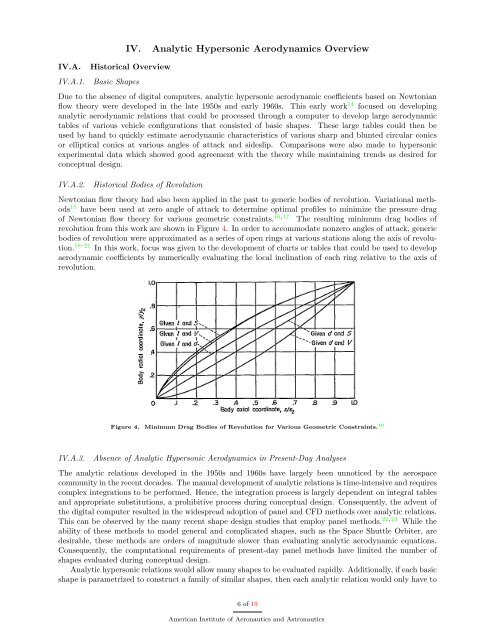Analytic Hypersonic Aerodynamics for Conceptual Design of Entry ...
Analytic Hypersonic Aerodynamics for Conceptual Design of Entry ...
Analytic Hypersonic Aerodynamics for Conceptual Design of Entry ...
Create successful ePaper yourself
Turn your PDF publications into a flip-book with our unique Google optimized e-Paper software.
IV.A. Historical Overview<br />
IV.A.1. Basic Shapes<br />
IV. <strong>Analytic</strong> <strong>Hypersonic</strong> <strong>Aerodynamics</strong> Overview<br />
Due to the absence <strong>of</strong> digital computers, analytic hypersonic aerodynamic coefficients based on Newtonian<br />
flow theory were developed in the late 1950s and early 1960s. This early work 14 focused on developing<br />
analytic aerodynamic relations that could be processed through a computer to develop large aerodynamic<br />
tables <strong>of</strong> various vehicle configurations that consisted <strong>of</strong> basic shapes. These large tables could then be<br />
used by hand to quickly estimate aerodynamic characteristics <strong>of</strong> various sharp and blunted circular conics<br />
or elliptical conics at various angles <strong>of</strong> attack and sideslip. Comparisons were also made to hypersonic<br />
experimental data which showed good agreement with the theory while maintaining trends as desired <strong>for</strong><br />
conceptual design.<br />
IV.A.2. Historical Bodies <strong>of</strong> Revolution<br />
Newtonian flow theory had also been applied in the past to generic bodies <strong>of</strong> revolution. Variational methods<br />
15 have been used at zero angle <strong>of</strong> attack to determine optimal pr<strong>of</strong>iles to minimize the pressure drag<br />
<strong>of</strong> Newtonian flow theory <strong>for</strong> various geometric constraints. 16, 17 The resulting minimum drag bodies <strong>of</strong><br />
revolution from this work are shown in Figure 4. In order to accommodate nonzero angles <strong>of</strong> attack, generic<br />
bodies <strong>of</strong> revolution were approximated as a series <strong>of</strong> open rings at various stations along the axis <strong>of</strong> revolution.<br />
18–21 In this work, focus was given to the development <strong>of</strong> charts or tables that could be used to develop<br />
aerodynamic coefficients by numerically evaluating the local inclination <strong>of</strong> each ring relative to the axis <strong>of</strong><br />
revolution.<br />
Figure 4. Minimum Drag Bodies <strong>of</strong> Revolution <strong>for</strong> Various Geometric Constraints. 16<br />
IV.A.3. Absence <strong>of</strong> <strong>Analytic</strong> <strong>Hypersonic</strong> <strong>Aerodynamics</strong> in Present-Day Analyses<br />
The analytic relations developed in the 1950s and 1960s have largely been unnoticed by the aerospace<br />
community in the recent decades. The manual development <strong>of</strong> analytic relations is time-intensive and requires<br />
complex integrations to be per<strong>for</strong>med. Hence, the integration process is largely dependent on integral tables<br />
and appropriate substitutions, a prohibitive process during conceptual design. Consequently, the advent <strong>of</strong><br />
the digital computer resulted in the widespread adoption <strong>of</strong> panel and CFD methods over analytic relations.<br />
This can be observed by the many recent shape design studies that employ panel methods. 22, 23 While the<br />
ability <strong>of</strong> these methods to model general and complicated shapes, such as the Space Shuttle Orbiter, are<br />
desirable, these methods are orders <strong>of</strong> magnitude slower than evaluating analytic aerodynamic equations.<br />
Consequently, the computational requirements <strong>of</strong> present-day panel methods have limited the number <strong>of</strong><br />
shapes evaluated during conceptual design.<br />
<strong>Analytic</strong> hypersonic relations would allow many shapes to be evaluated rapidly. Additionally, if each basic<br />
shape is parametrized to construct a family <strong>of</strong> similar shapes, then each analytic relation would only have to<br />
6 <strong>of</strong> 19<br />
American Institute <strong>of</strong> Aeronautics and Astronautics

















